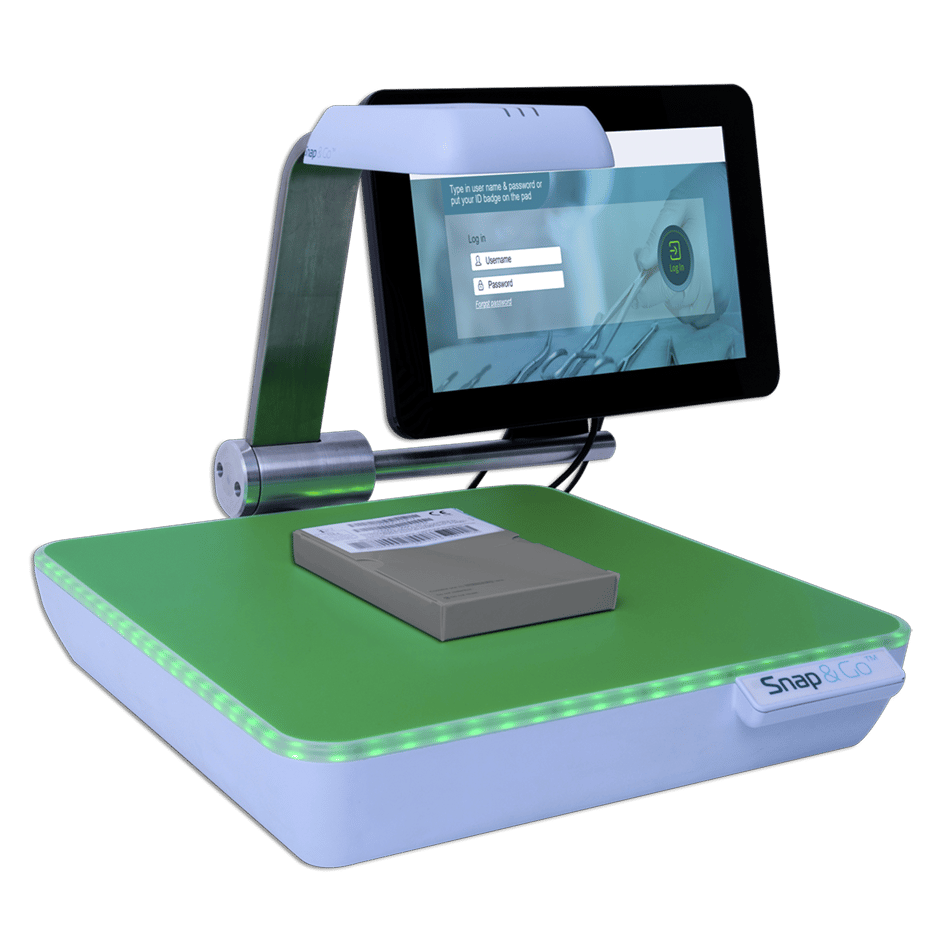What’s inside:
GS1 in Healthcare
The GS1 in Healthcare Standards support healthcare supplies item tracking, but to work well in practice, they require fit-for-purpose data collection tools. In this article find out:
- The ‘four G’s’ relating to GS1
- The three elements of the GS1 Standards in Healthcare
- The challenges faced by health care providers for each of the GS1 elements
- Why inadequate data capture tools are hampering GS1 success
- How computer vision is revolutionizing point of care data capture, making GS1 a far simpler task
The role of GS1 in the healthcare supply chain
In the run up to the GS1 Paris Healthcare Conference on November 15th, IDENTI takes a moment to review the GS1 Healthcare Standards and to discuss the importance of robust POU data capture tools in the GS1 process. GS1 standardizes supply chain data by using a global identification system that supports end-to-end traceability from manufacturing right though to consumption.
Why are the GS1 Standards needed?
The GS1 Standards provide uniformity and consistency in the identification and tracking of products.
GS1 explains the need for the standards as follows, “Numerous studies have shown that automatic identification throughout the entire Healthcare supply chain, right to the point of delivery to the patient, is an extremely effective tool in preventing medication errors. However, global standards are needed for an effective and efficient roll-out of automatic identification systems in the healthcare sector.”
They continue, ‘Healthcare is by nature a global sector, with supply chains that often cross borders. A global standardised system for traceability, from product manufacture to patient treatment, is imperative to comply with the increasing legal requirements for product traceability around the world.’
The GS1 standards are a common language for the supply chain.
Difference between GS1 and GTIN
Before we dive deeper into this topic, let’s make sure we have the basics. Did you know that there are actually four G’s that relate to the GS1 standards?
Let’s go through each one in order to provide some clarity:
- GDSN is the Global Data Synchronization Network that sits between vendors and healthcare providers. It provides a globally recognized common set of data to ensure supply chain uniformity.
- GS1 is the global standards body for transparent item identification. It is the central system that stores all the standard-compliant data.
- GLNs are Global Location Numbers issued by GS1 that are used to identify the location of items in the supply chain.
- GTINs are Global Trade Identification Numbers issued by GS1 that are contained within the barcode. It is this unique identifier that plays a central role in ensuring the tracking and traceability of items such as implants and medical devices throughout the supply chain. GTINs provide an electronic link between products and patients.
Together the ‘Four G’s ‘define how the key players in the supply chain store and transfer data – facilitating the smooth exchange of information between different parties.
The challenge of POU data capture
GS1 has certainly provided clarity, uniformity and structure, which are great foundations for achieving end-to-end tracking, but as with so many well-designed systems, when it comes down to implementation, an organization’s internal, operational challenges can hinder success.
The GS1 Standards support the achievement of data-driven healthcare based on a uniform, global system that drives through hospital supply chain efficiencies. The standards and the systems set up to support the GS1 standards ensure that data is captured locally and then shared with key systems, contacts and partners. Having accurate, central, accessible data gives transparency and visibility, supporting organizational cohesion.
But it’s not about data. It’s about healthcare. Getting the data right boosts clinical and operational performance and underpins patient care.
In order to ensure accurate and timely data collection, hospitals and ambulatory care providers need efficient data-capture tools, but sadly it is the limitations of these tools that commonly slows up the GS1 process.
This article will look at how the point of use data capture of medical devices and implants is the weak point in the workflow for many healthcare organizations. We’ll end by showcasing a simple solution that is proving to be an easy fix.
The purpose of GS1 Standards in Healthcare
The GS1 Standards in Healthcare are part of the wider Unique Device Identification (UDI) framework that uses global GTIN reference numbers as the single identifier for medical devices and implants. GS1 is basically a UDI issuing agency.
GTIN barcodes are placed on product packaging by the manufacturer and this data is scanned and read as the item moves along the supply chain. To be effective, the GS1 GTIN process relies upon accurate data collection at each point of an item’s journey, right up until its final destination – consumption by the patient.
Let’s start by reviewing the GS1 Healthcare Standard’s three stage process.
The three elements of GS1 Standard in Healthcare
The GS1 Healthcare Standards have three core elements:

Each of these stages is important in achieving the smooth tracking of medical devices.
1. Identify
How do healthcare providers use the GTIN code to identify items? When a new delivery reaches a healthcare provider, the GTINs are used to log products as inventory items. Each GTIN is logged on the Item Master and will be used as the central identifier on hospital systems.
GTIN Identification challenges: The GS1 healthcare system generally works well, but local system issues, such as non-stock items bypassing the hospital system and scanned items failing to find a match in the hospital item master, will have repercussions when it comes to digital item identification and recording.
2. Capture
What is GTIN capture? A product’s GTIN code and any other encoded information, eg. batch number and expiry date, need to be electronically captured in order to transfer vital item data onto the hospital’s information systems.
Once loaded, the GTIN is used as the central identifier. For example, at the point of care, a GTIN number is used to identify and digitally document items captured during surgery.
GTIN Capture challenges: The point of use is known to be the weakest link for item tracking, with utilization data being far from simple to capture. Perioperative software for data capture is not routinely providing the robust documentation required by the regulations.
Automatic identification systems at the point-of-care aim to match product data to patient data. Barcode scanning is the most common tool used at the POC yet is known to be inefficient in dealing with the full vatrety of medical inventory used in surgery. The following problems can arise in the surgical setting:
- Last minute deliveries and trunk stock items arrive directly into the procedure room and may not be loaded on the ERP.
- Stock variance is challenging, with products from new vendors, or substitute products from existing vendors, not existing in the system.
- Data capture tools can fail to read creased or defective barcodes
- The hospital’s source of truth may not keep pace with changing GTINs, eg. with new batch numbers.
For all of these scenarios, when the time comes to scan the item at the point of care, their GTIN code is not recognized by the hospital’s system, so the item cannot be identified or recorded in the regular way.
When ineffective POU barcode scanning causes the workflow to fall down, frustrated nursing staff have to resort to longwinded, manual workarounds that often have to be completed when surgery is over and due to administrative difficulties may not result in successful data capture.
While in theory many healthcare providers have automated processes to identify and trace products, these are reliant upon full, accurate and timely data capture.
3. Share
What is GTIN sharing? Consumption recorded during surgery populates the patient record and this data is then shared with other hospital information systems to complete a variety of workflows, eg. supply chain, billing.
Accurate usage documentation supports:
- Tracking healthcare inventory and kits in the event of a product recall
- Complete and timely medical billing
- Data driven inventory management
This vital data is not only used internally, it can also be shared with other parties, such as vendors.
Utilization data is a crucial element of the supply chain. When providers and vendors have full inventory vision they can:
- Gain a mutual understanding of the organization’s supply chain needs
- Ensure the prompt replacement of used items
- Agree on invoices
- Monitor contracts
- Drive supply chain efficiencies and costs savings based on accurate data
- Encourage harmonious working relationships between organizations
If GTIN data is not captured at the point of use and is therefore unavailable for sharing, it has an organizational knock-on effect.
GTIN Sharing Challenges: Items that have circumvented the standard supply chain workflow and are consequently not documented at the point of care – are basically invisible – distorting the true picture of inventory levels and consumption. This can have patient safety implications, lead to lost revenue, cause supply chain inefficiencies and trigger disagreements between hospitals and vendors.




Inadequate POU data capture technology is hampering efficient GS1 implementation
The GS1 Standards in Healthcare provide an excellent framework for hospitals and ASCs to achieve end-to-end medical device and implant tracking. GS1 deserves supporting tools that grease the wheels of the standards and facilitate the full capture of GTIN data. As we have seen, a crucial and failing workflow for implant and medical device tracking is at the point of use, so maybe it’s time to leverage the power of technology to improve the capture of utilization data?
Many healthcare providers admit that gaining full and accurate usage data is a complex and time-consuming task. As the variety of medical inventory used in surgery becomes ever more complex, inadequate data collection tools are making POU utilization an unnecessarily complicated task.
Thankfully, new technology is now available, offering an alternative to barcode scanners and providing a quicker, easier way to collect GTIN data at the point of use.
The point of use data capture tool that eases GS1 implementation
IDENTI’s Snap & Go takes a brand-new approach by using cutting edge image recognition and AI technology. Snap & Go does not use barcode scanning, it takes an image of the product packaging, and this is then processed by cloud software, a global SKU database and advanced AI and machine learning algorithms, resulting in the identification and digital recording of the item in the hospital’s EHR.
Taking a ‘snap’ of each item takes just 3 seconds and results in 100% item capture, identification and documentation.
Hospitals using this new technology report back on the ease of use and accuracy of recording.
Snap & Go is the ideal surgical data capture solution for those organizations looking to improve their implementation of the GS1 Standards for Healthcare.

GS1 Hybrid Conference 2022
GS1’s hybrid conference will be looking at the relevance of the GS1 Healthcare Standards in the modern healthcare setting. But as the conference dives deep into all things GS1 – IDENTI wants to shine a light on the inefficiency of many data capture tools and spread the word about Snap & Go, the newest, easiest method to capture GTIN coding at the point of care.
It’s time to upgrade your POU data capture tools.
With Snap & Go on the scene, computer vision technology has arrived and POU barcode scanners are becoming a redundant relic.
Documenting utilization should be a simple, routine task. That may not be your experience now, but with Snap & Go it soon could be.
Watch a video of Snap & Go to see 3 second item capture for yourself!
Contact us for a demo!

(‘Identify, capture, share’ image from: How GS1 standards work | GS1)








